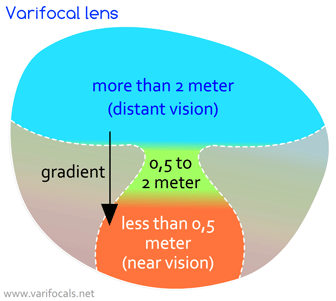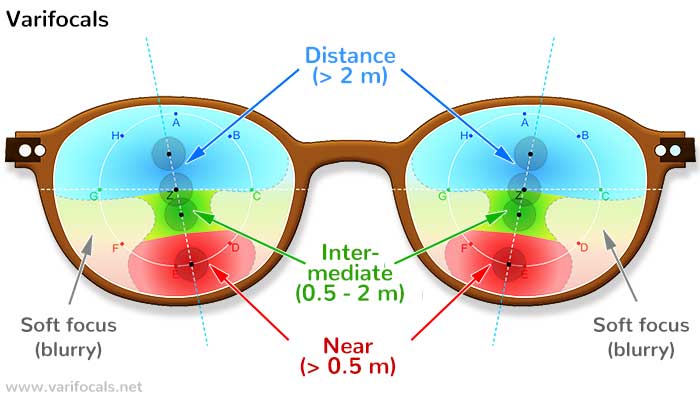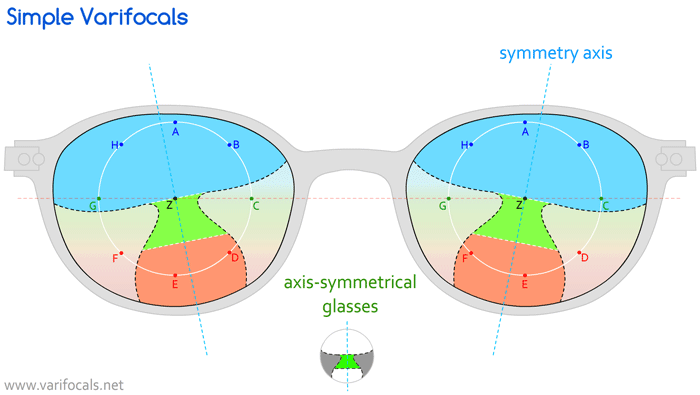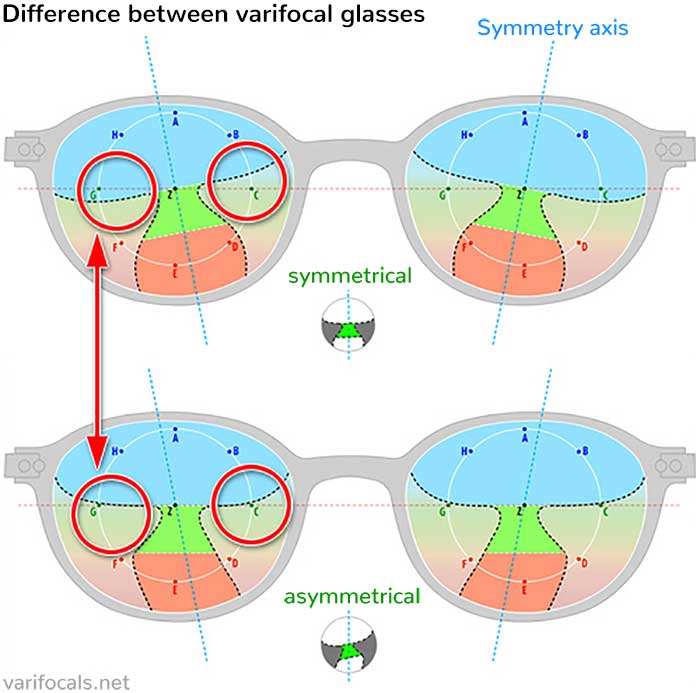Varifocals: Perfect vision - Smart eyes

Varifocal lens
A varifocal lens is divided into three zones: the upper area is optimized for the distance, the lower area corrects the close-up view (reading distance). The zone in between is fluid / gliding and is optimal for intermediate distance. That's why they are also called progressive lenses.
Varifocal Lenses (varifocals) are used as glasses in frames or as contact lenses.
Over time, the eyesight of the eye deteriorates - one becomes presbyopic. The reason for this is a decreasing flexibility of the eye lens. This hardening of the lens leads to a diminished accommodation capacity of the eye - which in turn means that it is no longer possible to see clearly at close range. Reading glasses are therefore required for close-up vision. Varifocals can correct several vision impairments with one pair of glasses.

What is a varifocal lens glasses?
At what age and with which visual acuity are varifocals useful or even necessary? For people with myopia (short-sightedness) a problem arises from a certain age: for long-distance vision they need long-distance glasses, but due to the onset of presbyopia they also need reading glasses. If you don't want to switch back and forth between two pairs of glasses, you can buy a pair of varifocals instead, with which you can see clearly and sharply at any viewing distance. But as the age-related vision system is slowly developing over many months and years, many people are asking themselves the question: when is the right time to buy these relatively expensive progressive glasses?

Different types of varifocals
The special feature of varifocals is the smooth transition between distance vision and near vision. The area for the intermediate distances is called the progression zone. This transition area of the progressive lens is of decisive importance for the quality of progressive spectacles. In the meantime, some lens manufacturers have started to develop special lens designs for different areas of use. Here, the position and size of the individual zones define the suitable form of use of the glasses.
How large is the progression zone?
The progression zone can be of different sizes. It is bounded at the top by the distance vision, and at the bottom by the near vision (zone). On the sides there are transition zones, which are mainly important for the optics of the lens. In these peripheral areas, no really sharp vision is possible. For this reason, varifocals also allow only limited vision out of the corners of the eye.
Characteristics of the Progressive Lens
A progressive lens is a type of multifocal glasses. The special feature lies in the unique lenses, which correct not only refractive visual impairments at one distance but multiple distances simultaneously. The "refractive visual impairments" include commonly occurring vision problems:
- Nearsightedness
- Farsightedness
- Presbyopia
- Astigmatism
A progressive lens becomes relevant when nearsightedness (often congenital) is accompanied by age-related presbyopia. In such cases, distance vision is not clear (due to nearsightedness), and near vision also becomes increasingly challenging (due to presbyopia). The progressive lens can correct both issues thanks to its unique lens design.

Top: Distance vision (over 2 meters);
Middle: Intermediate distances (0.5 to 2 meters), e.g., computer screen;
Bottom: Near vision (less than 0.5 meters), e.g., reading a book;
the lateral zones on the left and right are smoothly curved and often lead to a slightly blurry image
Lens design becomes better and better
The progressive lens manufacturers (e.g. Zeiss, Rodenstock, Essilor) are researching new "lens designs" that differ primarily in terms of the size / extent of the progression zone. As a result, different types of progressive lenses are now available on the market. Please click for more information:
- Simple standard varifocals (symmetrical axis, cheap)
- Varifocals with asymmetrical axis (better lens design)
- Panoramic varifocals for car driving
- Workspace varifocals - middle distance
- Digital varifocals for smartphones, tablets etc.

Advantages and disadvantages of varifocals
Advantages of varifocals
- The smooth transition between different strengths is often perceived as more comfortable compared to bifocal or trifocal lenses.
- Progressive lenses provide sharp vision even in intermediate distances.
- They are less noticeable and offer an aesthetic advantage.
- With early adaptation and customized lens design, the adaptation period is usually minimal.
Disadvantages of varifocals
- Sharp vision through pupil movements is only partially possible. For example, when cycling, one may need to tilt the head downwards to see the path in front of the bike.
- The adaptation period is often longer for late adopters compared to conventional multifocal lenses.
- The visual zones for distance and near vision are smaller than in single-vision glasses, and the progression zone in cheaper models may be relatively narrow.
- Distortions, particularly at the edges, may occur due to the "swim effect," but individuals typically get used to it.
- Estimating distances may be challenging during the adaptation phase.
- The cost of progressive lenses is significantly higher, but it eliminates the need for multiple glasses and the risk of misplacing the needed pair.
What are the common eye defects and problems?
They include: myopia (nearsightedness), which is when far-away objects look blurry. hyperopia (farsightedness), which is when close-up objects look blurry. astigmatism, which can result in blurry vision because the cornea is not perfectly shaped to direct light into the eye.
